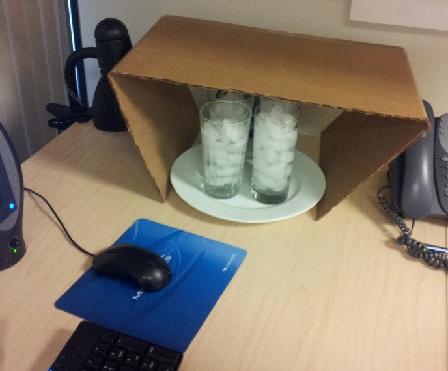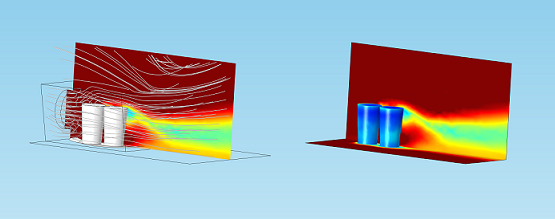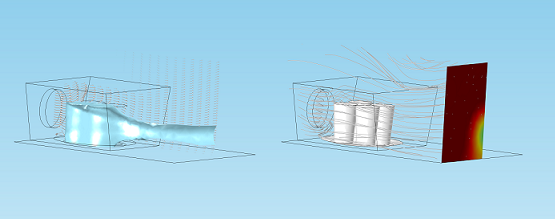
Make-shift Air Conditioner: How Engineers Can Stay Cool at Work (Maybe)
The winter here in Boston has been very mild so far. A few days I would even have liked to have the air conditioning back on. I checked in with one my colleagues to check if he was having an equally hard time staying cool, and to my surprise, he was not. Why? He had constructed a make-shift air conditioner (A/C).

Make-shift air conditioner: four glasses filled with ice and water standing on a plate housed by a folded piece of cardboard. A small fan is sitting behind the glasses (not shown).
At first sight, this MacGyver-like contraption didn’t seem to be an efficient way to cool air. It went against all the principles and tricks I learned during my heat transfer classes back in University. My colleague claimed that once the fan was powered on, this homegrown A/C would provide him with fresh air in less than five minutes. There was no way to measure the temperature of the airflow as I don’t typically carry a thermometer around. Hence, the efficiency of the A/C was based on how cold we felt the airstream was. Heat transfer is a fascinating subject, especially when convection is involved. We were not willing to leave the A/C’s performance evaluation to subjectivity, so we wondered: can we model it in COMSOL Multiphysics?
Modeling a Make-Shift Air Conditioner
As it turns out, this last-minute air conditioner is another elegant multiphysics example involving heat transfer, fluid flow, and temperature-dependent material properties. I was able to model it in COMSOL, and the verdict is in.
Given the results obtained from the simulation (see the images below) I can now safely say that I was right in questioning the performance of my colleague’s homemade A/C. Essentially, the geometry of the cardboard, the shape of the glasses filled with ice, and the operating conditions are not really promoting the heat exchange between the airstream and the cold glasses. For example, the outlet air velocity profile is such that, with respect to the room temperature, the mass-weighted average temperature is not lowered by much.

Streamlines and temperature distribution after 10 minutes.

Isosurface (T=22 °C) and outlet temperature distribution after 10 minutes.
Some Questions for You
Have you ever had to build an emergency air conditioner? Did you come up with a better solution than my colleague? When dealing with simulating thermo-CFD applications, do you usually use the mass-weighted average temperature? Let us know in the comments below!
Ps. If you liked this post, you might also like “Solar Radiation: How Engineers Can Stay Cool on the Beach (Maybe)”.



Comments (0)